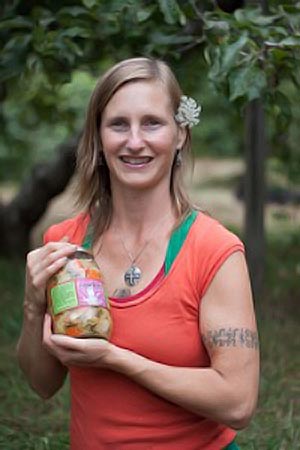 Our Story
Our Story
2001 was a harsh year for me. I was running my body on empty. I was working 3 part-time jobs, going to school full-time and commuting from Salt Spring Island to Vancouver every week. Eventually, my immune system broke down and I was diagnosed with fibromyalgia.
I made my first gallon of kimchi. I just used a basic recipe from Paul Pitchford’s Healing with Whole Foods, a book that at that point in my life I called “my bible”. I hoped that the kimchi would help my body absorb more nutrients so that my body could heal. As well as going on a sweetener and gluten free diet all summer, I am convinced that it worked. I also spent that summer growing my own vegetables grains and beans. I thought that if I could connect to the land that nourished me, then I could connect to my body that needed to be nourished.
This worked, and i realised how beneficial bacteria are needed in the soil to grow healthy food, and also how they are needed in my gut to grow a healthy body. When I realized how important beneficial bacteria are to our existence, the seed of health was planted in my life. Where would we be without all the microflora in the dirt breaking down nutrients for plants to grow from and keep pests away? Likewise, where would we be without all the microflora in our gut-breaking down food for us to thrive off and stave away disease?
The next year, I had the privilege to live in a community in Zimbabwe for two years where I taught nutrition, healthcare and gardening. As with any teaching job, I learned more than I taught. I spent a lot of my time there researching. I spoke with elders in the rural areas and urban townships about how they prepare and preserve food without refrigeration or electricity. I was gifted with many stories, most with the same theme of fermentation. Historically, and to some extent still, grains were fermented and made into nourishing, thirst quenching drinks drunk daily to quell the heat of the sun.
Upon reading, Sally Fallon’s Nourishing Traditions, and Sandor Katz’s Wild Fermentations, I learned that almost every culture the world over ferments some kind of food, and this food is what seems to define the society, or may I say defines the ‘culture’. Traditionally, in Zimbabwe, the brewing of beer is done only by the wise elder women of the clan, those who have reached menopause. The sacred brew is drunk during important ceremonies and poured on the graves of the ancestors as a way to honour them.
A few years after living in Zimbabwe, I wanted to diversify my fermenting skills. After taking a course with Sandor Katz, I was deeply inspired to share sauerkraut with my family and I had the vision of growing my own vegetables, fermenting them and offering them to the public.
The summer I was pregnant with my son Tinaye I became very tired due to low iron levels. I did some research, wondering how women cured themselves of anemia, and sure enough discovered that some women eat sauerkraut to help their bodies absorb iron from food. That was way more fun (and delicious!) than ingesting nauseating iron pills – especially after already experiencing 3 months of morning sickness!
So here we are now, my lively lovely son is seven years old and sauerkraut is a big part of our life. We eat carrot and ginger kraut with our eggs in the morning to start our digestion on the right foot, and to detox after a long nights sleep. For a snack, I like sauerkraut and cheese on rice cakes. We have potlucks with friends and I bring my latest variety of fermented vegetables for everyone to taste. On our regular Saturday pizza nights I bring kimchi as a topping, which seems to compliment all types of pizza. This year we had a bumper crop of beets and green beans, so we fermented the beans with dill, made kvass with the beets, and fermented the beet greens: live foods to eat all winter!
What I love most about selling kraut in the markets is meeting my customers, hearing stories from elders about how they survived the long cold winters eating sauerkraut (I hear this story a surprising amount!), hearing stories of healing due to eating sauerkraut, and giving mouthfuls to the kids who visit the market week after week- they know me as the sauerkraut lady.

